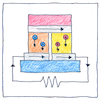Thomas Johann Seebeck,
Hans Christian Ørsted
electromagnetism

|
Thermoelectric effect
Thomas Johann Seebeck discovered in an electric circuit with a junction of two metals that heating or cooling one side of the junction resulted in an electric current that deflected the arrow of a compass. Seebeck thought he had discovered a thermomagnetic effect, but Hans Christian Ørsted observed that the magnetic deflection was a result of the generated current, and coined the term thermoelectricity.
Thermocouple and thermopile
Put a temperature difference across it— you generate a voltage to measure the temperature, which is called a thermocouple, or to generate electricity, which is called a thermopile.
Not by accident
It couldn’t have been an accident, a circuit tossed together from parts remaining from other experiments. I have friends who have said nothing is accidental. Unknowable past lives explain this one. Sometimes things click when everything makes sense and explanations fall into place.



Thomas Johann Seebeck and Hans Christian Ørsted are examples of remote partners, one to discover the phenomenon in 1821, and the other to explain it in 1834. The thermoelectric effect is also known as the Seebeck effect.
See also in The book of science:
Readings in wikipedia: